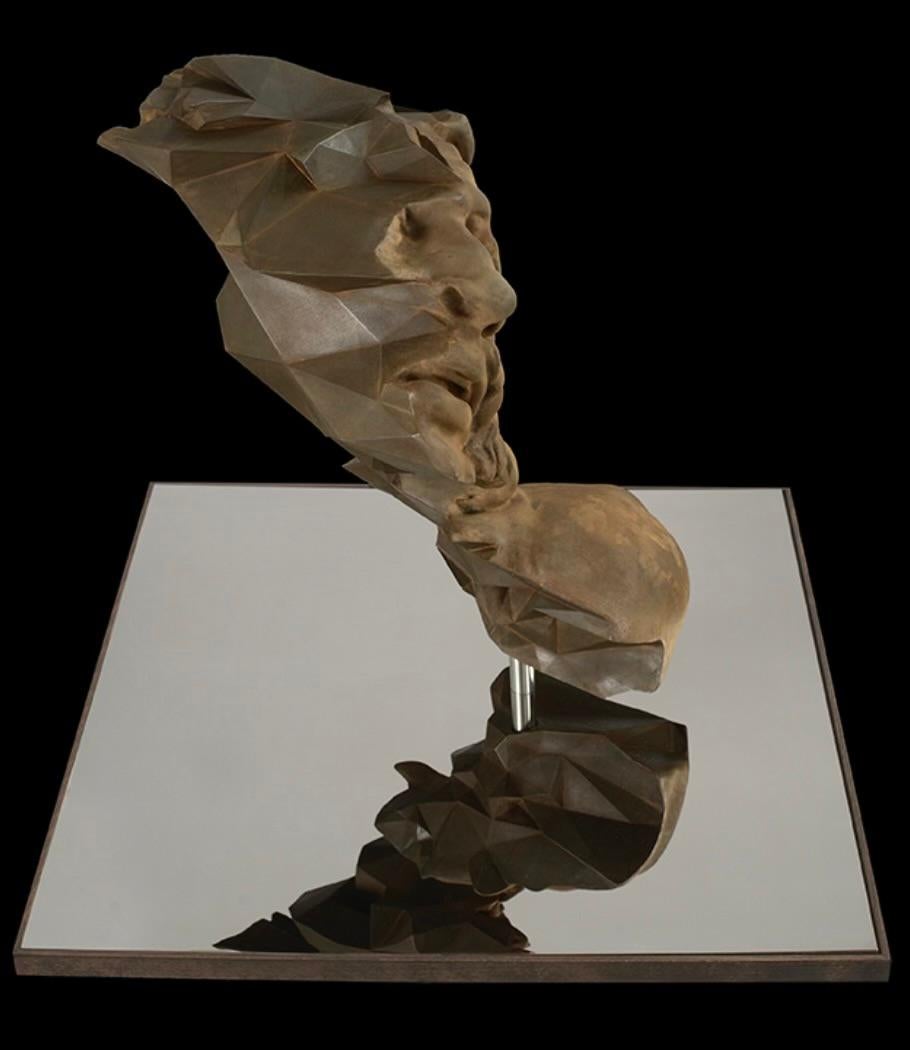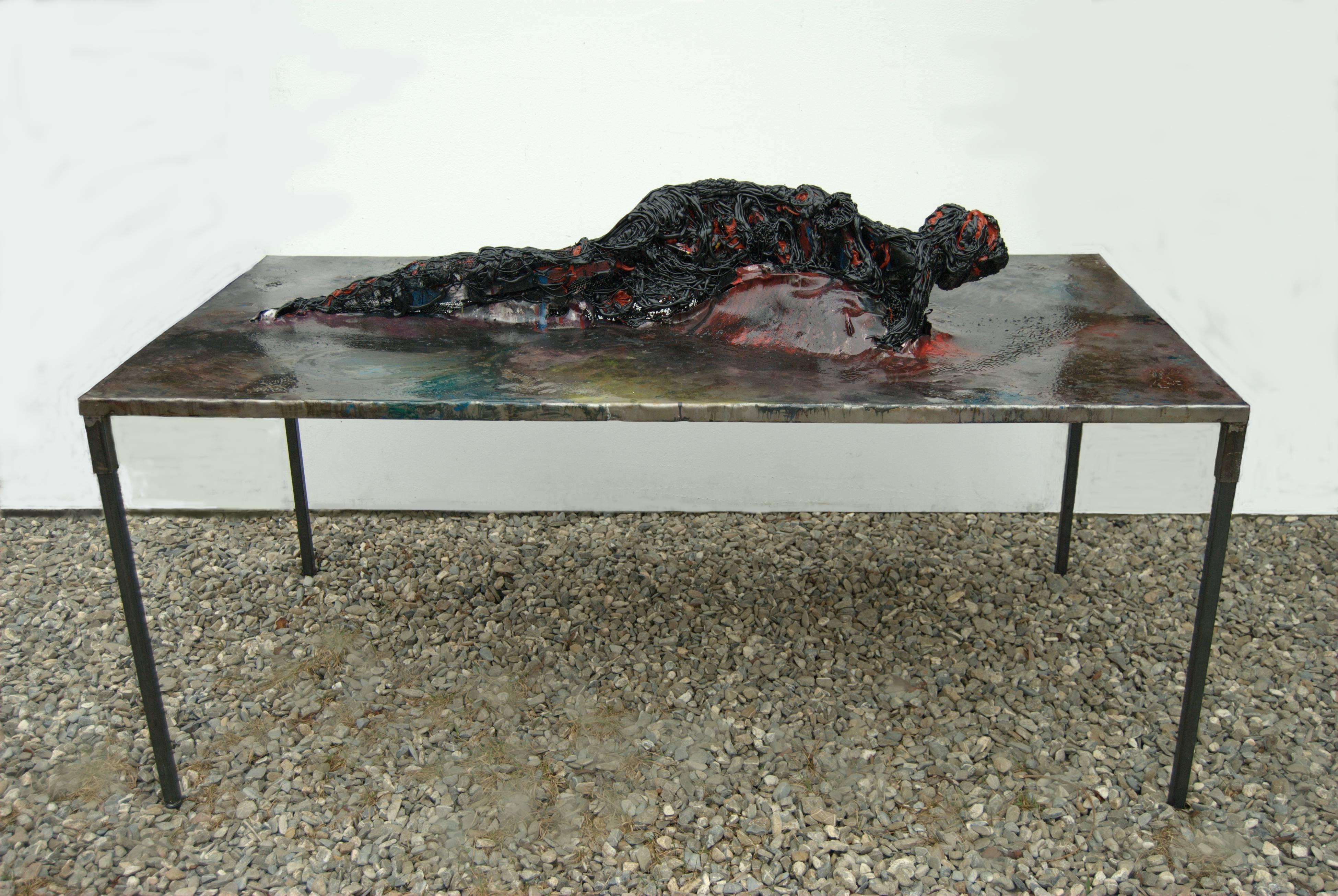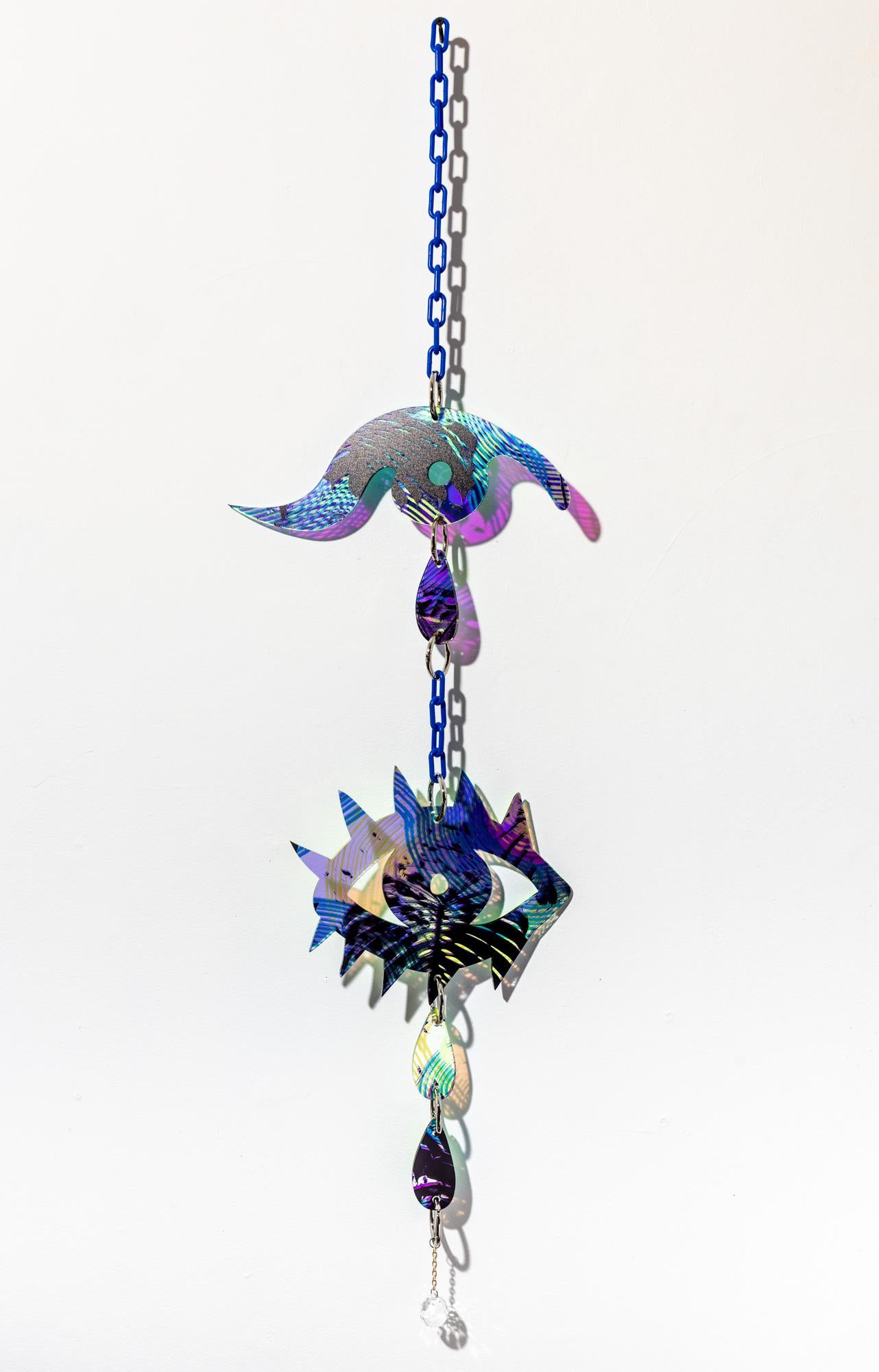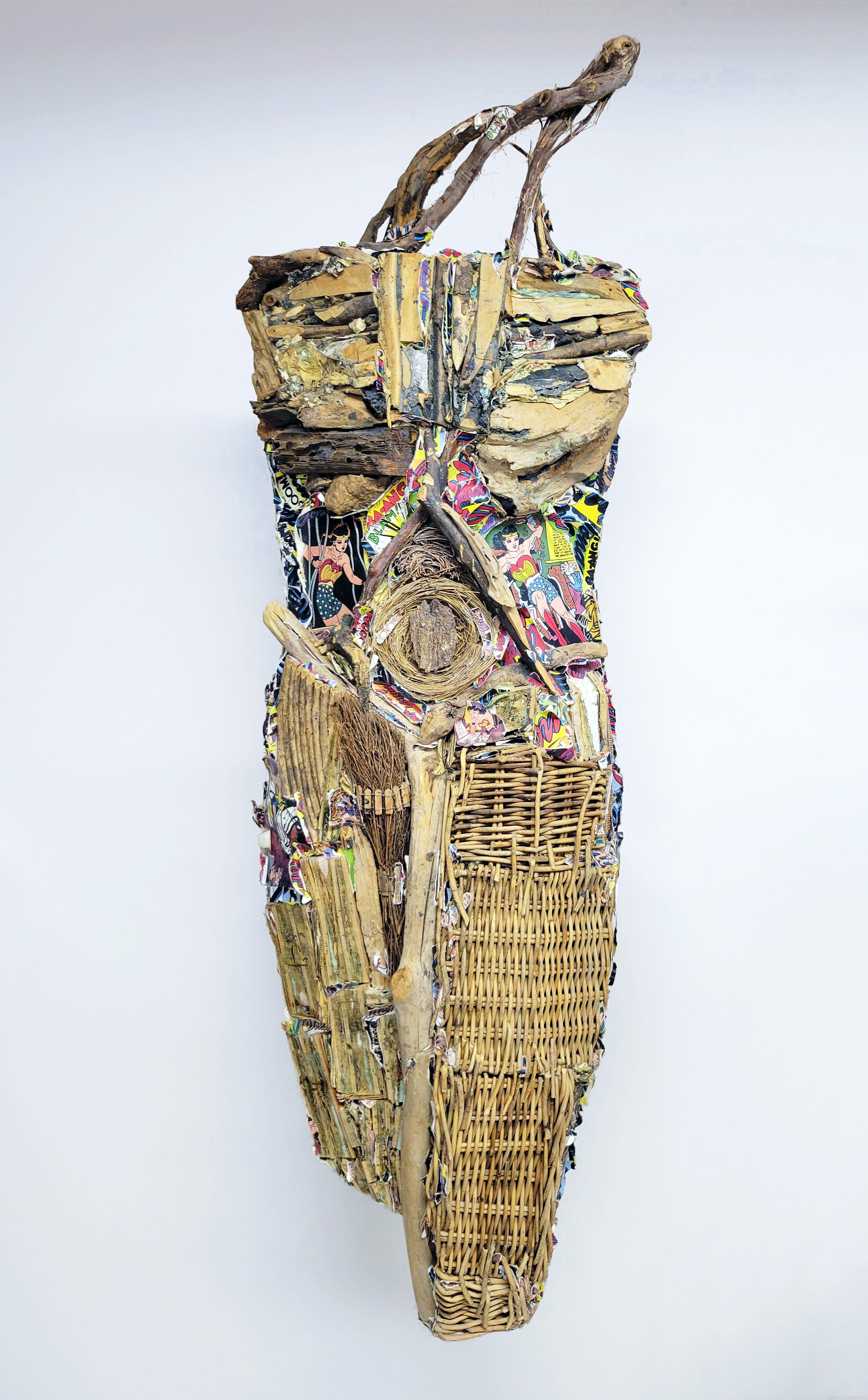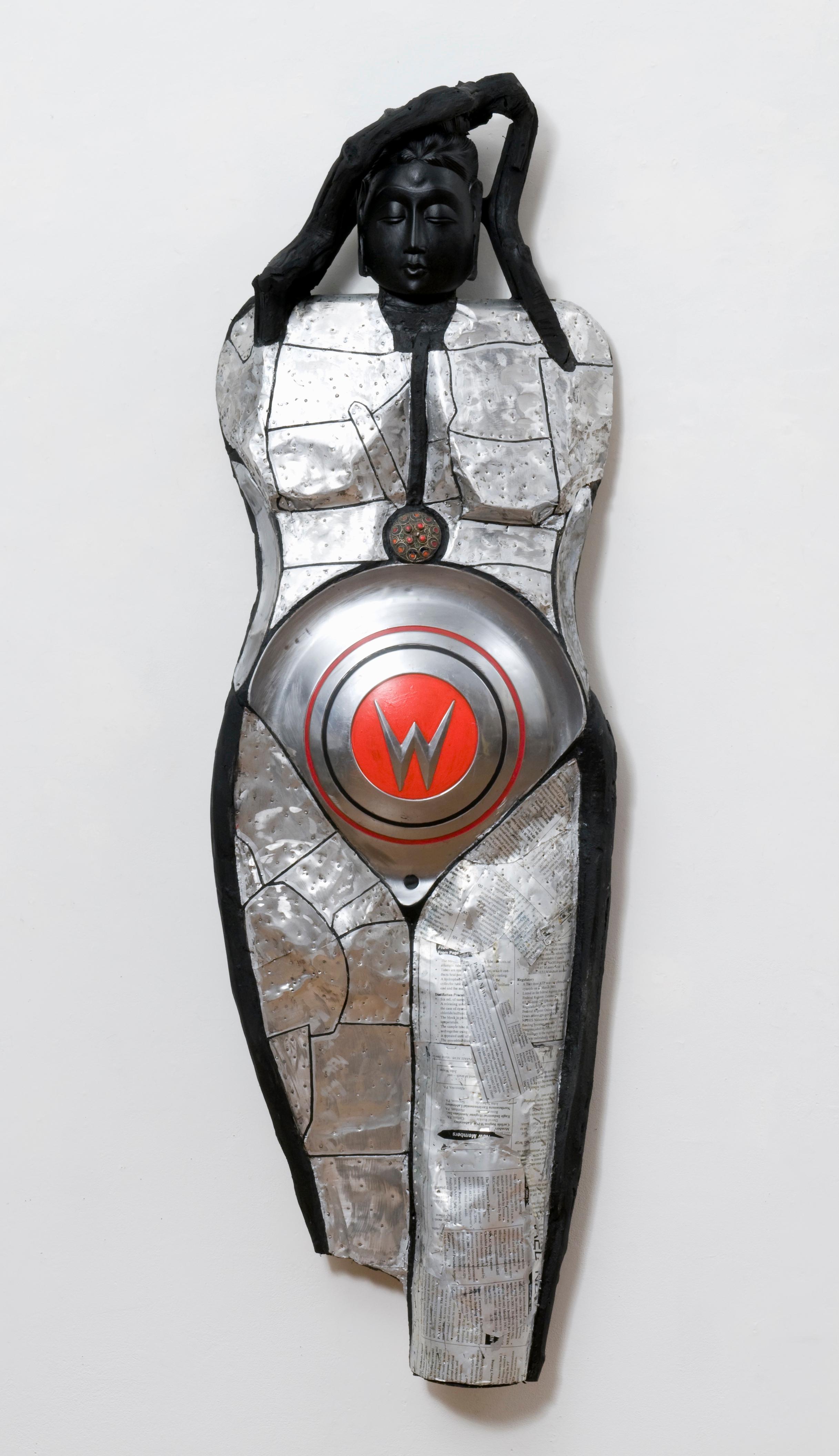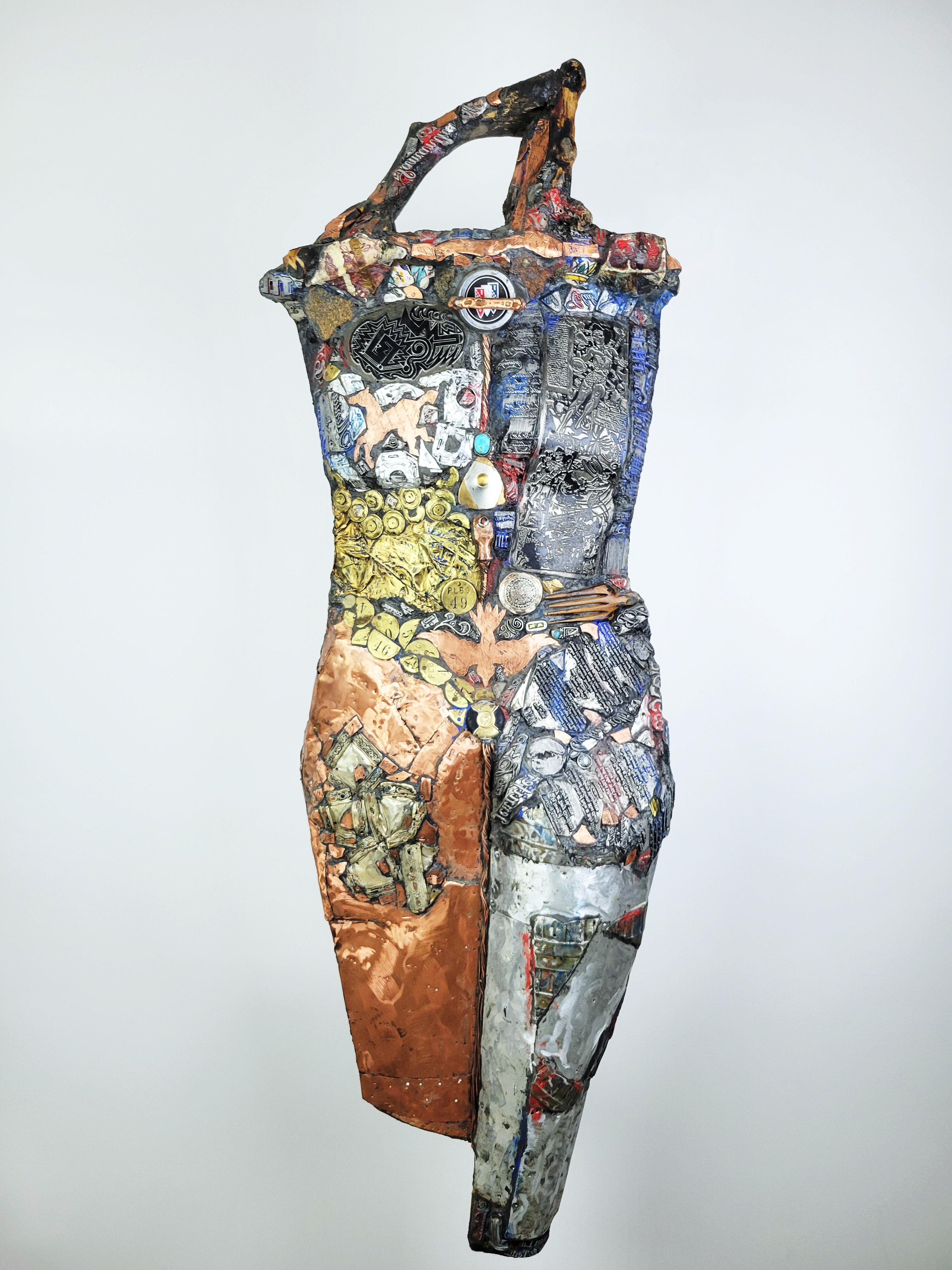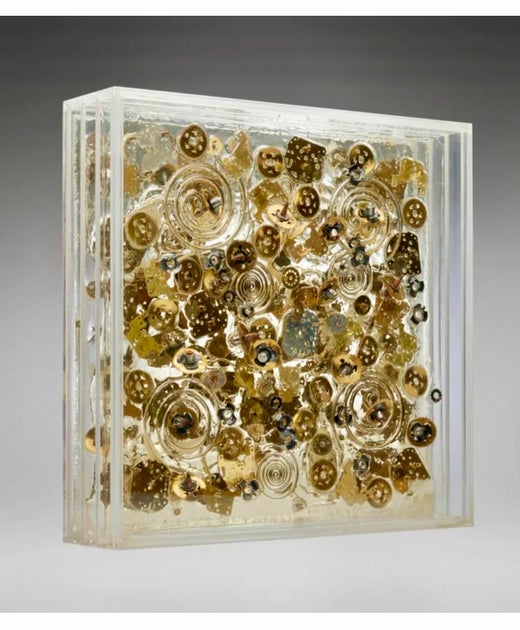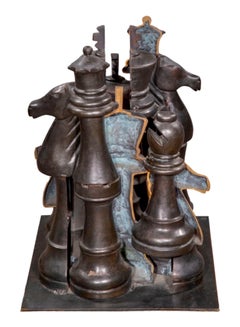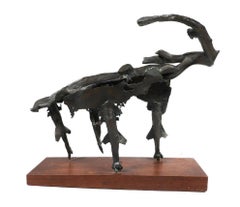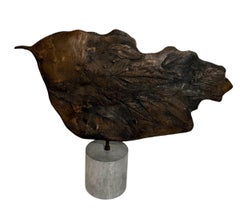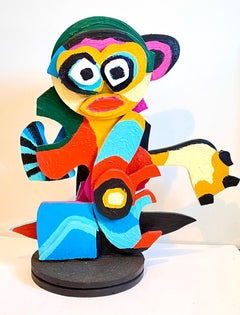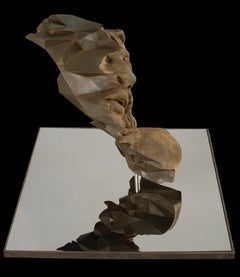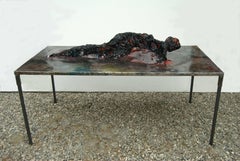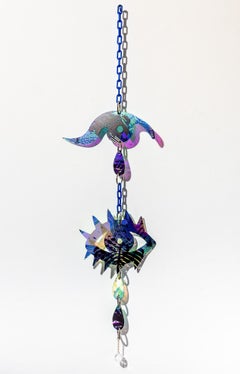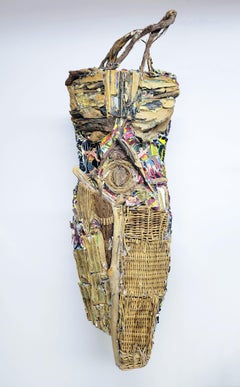Items Similar to French Pop Art Assemblage Sculpture Watch Movements Temps 2 Arman Accumulation
Want more images or videos?
Request additional images or videos from the seller
1 of 19
ArmanFrench Pop Art Assemblage Sculpture Watch Movements Temps 2 Arman Accumulation1976
1976
About the Item
Arman
Temps 2 (Mecanismes de montres)
1976
Accumulation of watch parts on three sheets of Plexiglas, encased in a box
Dimensions: 18.125 h × 18.125 w × 4.375 d in (46 × 46 × 11 cm)
Hand signed (incised and etched into the plexiglass) and numbered to lower edge 18/900 Arman. This work is number 18 from the edition of 900 published by Artcurial, Paris and is recorded in the Arman Studio Archives New York under number: APA# 8403.76.002. I do not know how many were actually produced.
Signature et Numéro Inscrire.
Arman (November 17, 1928 – October 22, 2005) was a French-born American artist. Born Armand Fernandez in Nice, France, Arman was a painter who moved from using objects for the ink or paint traces they leave ("cachet", "allures d'objet") to using them as the painting itself. He is best known for his "accumulations" destruction/recomposition of objects. From his father, Arman learned oil painting and photography. After receiving his bachelor's degree in philosophy and mathematics in 1946, Arman began studying at the École Nationale des Arts Décoratifs in Nice. He also started judo at a police school in Nice where he met Yves Klein and Claude Pascal. The trio bonded closely on a subsequent hitch-hiking tour around Europe.
Early on, it was apparent that Arman's concept of the accumulation of vast quantities of the same objects was to remain a significant component of his art. Ironically, he had originally focused more attention on his abstract paintings, considering them to be of more consequence than his early accumulations of stamps. Only when he witnessed viewer reaction to his first accumulation in 1959 did he fully recognize the power of such art. In 1962, he began welding together accumulations of the same kinds of metal objects, such as axes. some of these works were then cast in bronze at Foundry Bocquel, He also made many prints in various techniques including lithograph, silkscreen and etching. The camera, violin, trumpet and sliced musical instruments figure prominently in his Oeuvre and are the works Arman is known for. Inspired by an exhibition for the German Dadaist Kurt Schwitters in 1954, Arman began working on "Cachets," his first major artistic undertaking. At his third solo exhibition held in Paris's Galerie Iris Clert in 1958, Arman showed some of his first 2D accumulations he called "cachets." These stamps on paper and fabric proved a success and provided an important change of course for the young artist's career.
At the time, he was signing with his first name as an homage to Van Gogh, who also signed his works with his first name, "Vincent." And, thus, in 1957, Arman chose to change his name from Armand to Arman. On January 31, 1973, upon becoming a citizen of the United States, he took the American civil name, Armand Pierre Arman. Nevertheless, he continued to use "Arman" as his public persona.
In October 1960, Arman, Yves Klein, François Dufrêne, Raymond Hains, Martial Raysse, Daniel Spoerri, Jean Tinguely and Jacques Villeglé, and art critic and philosopher Pierre Restany founded the Nouveau réalisme group. Joined later by Cesar, Mimmo Rotella, Niki de Saint Phalle, and Christo, the group of young artists defined themselves as bearing in common their "new perspective approaches of reality." His work lies at the intersection of Pop art, fluxus and Dada sensibilities with a light dose of cubism. They were reassessing the concept of art and the artist for a 20th-century consumer society by reasserting the humanistic ideals in the face of industrial expansion.
Arman can be seen in the Andy Warhol film Dinner at Daley's, a documentation of a dinner performance by the Fluxus artist Daniel Spoerri that Warhol filmed on March 5, 1964. Throughout the portrait-screen-test film, Arman sits in profile, looking down, appearing to be entranced in his reading, seemingly unaware of Warhol's camera, only making small gestures, rubbing his eyes, and licking the corner of his mouth. He remained silent, eyes gazing over the pages of what seemed to be a newspaper, in this four-minute, 16mm black-and-white reel. Warhol owned two of Arman's Poubelles and another accumulation called Amphetamines, which were sold at Sotheby's auction of the Andy Warhol Collection in May 1988. He is known for his painting and sculpture in particular his assemblage and collage works.
Fascinated with the scene in New York, Arman took up part-time residency there from his home in Nice in 1961, after his first exhibition at the Cordier Warren Gallery. In the city, he met Marcel Duchamp at a dinner given by the artist and collector William Copley.
Arman often adopted destruction as a strategy for creation: He sliced, burned, and smashed objects such as bronze statues and musical instruments, then mounted fragments on canvas, encased them in resin or plexiglass, or presented them alone. In the 1960s, he was associated with Nouveau Réalisme—a European movement founded in response to American Pop art—along with close friend and fellow artist Yves Klein. Artcurial published Salvador Dali as well as Claude Lalanne and Xavier Lalanne. Arman exhibited extensively throughout his lifetime and received numerous awards. His work has sold for six figures at auction and belongs in the collections of the Museum of Modern Art, the Hirshhorn Museum and Sculpture Garden, the Tate, the Stedelijk Museum, and the Tel Aviv Museum of Art, among other institutions.
Selected exhibitions and awards
Arman, Stedelijk Museum, Amsterdam, Holland
Arman, Walker Art Center, Minneapolis, Minnesota
Arman, Palazzo Grassi, Venice, Italy
Musée des Arts Decoratifs, Paris, France; *Louisiana Museum of Modern Art Arman, Modern Art Museum, Stockholm, Sweden
Arman, Artcurial auction house, Paris, France
Arman: A Retrospective 1955 - 1991, The Brooklyn Museum, Brooklyn, New York; The Detroit Institute of Art, Detroit, Michigan
Arman, Musée du Jeu de Paume, Paris, France
Arman, Tel Aviv Museum of Art, Israel
Arman: Arman, Museum of Contemporary Art of Teheran, Teheran, Iran
Arman, Marlborough New York City
Arman, a retrospective, Centre Georges Pompidou, Oct. 2010, Paris
Arman, retrospective, Museum Tinguely, Feb. 2011, Basel, Switzerland
Arman-in les Baux de Provence, July-Oct. 2011, Les Baux-de-Provence
Paul Kasmin Gallery, New York
Public collections in the U.S.A., selected
Fine Arts Museums of San Francisco, California
Hirshhorn Museum and Sculpture Garden, Washington, D.C.
Harvard Art Museum, Cambridge, Massachusetts
The Detroit Institute of Arts, Detroit, Michigan
The Museum of Modern Art, New York
- Creator:Arman (1928 - 2005, French)
- Creation Year:1976
- Dimensions:Height: 18.25 in (46.36 cm)Width: 18.25 in (46.36 cm)Depth: 4.38 in (11.13 cm)
- Medium:
- Movement & Style:
- Period:
- Condition:minor wear typical for age and materials. please see photos.
- Gallery Location:Surfside, FL
- Reference Number:1stDibs: LU38216104692
Arman
Arman was born in Nice, France, in 1928, and showed a talent for painting and drawing as a child. He studied at the the Ecole Nationale des Art Décoratifs in Nice followed by studies at the École du Louvre in Paris. In his early years he focused on abstract paintings. Then, in 1957, he became interested in common objects as works of art. He first did what came to be called his "allures d"objet" (object impressions), where he would dip an object into paint and press it on canvas thus leaving the object's shadow or impression. Then he decided the object itself was worth paying attention to and started to treat them in his own way. His intention was to remove the material purpose of an object so that its only remaining function was to "feed the mind" as a work of art. What better way to achieve that result than by breaking, slicing or even burning objects such as violins, telephones, typewriters or even whole cars? He also made objects useless by accumulating them, such as 2,000 wristwatches in a Plexiglass box that all kept different time. Once emotionally detached from the circumstances associated with a broken object, the viewer could grow to appreciate its abstract beauty; so, in a sense, Arman was literally teaching that things one never thought could be regarded as attractive could indeed turn out to be so. Through this achievement, Arman gained worldwide recognition and is regarded as one of the most prolific and inventive creators of the late 20th century. His work can be found in the collections of numerous museums including the Metropolitan Museum of Art in New York, the Tate Gallery in London and the Centre Pompidou in Paris. Arman’s work has also been exhibited in galleries, museums and public spaces worldwide including the Musée D’Art Contemporain in Tehran, Iran; the Museum of Art in Tel Aviv, Israel; the Musée Des Arts Decoratifs and Opéra De Paris in France; the La Jolla Museum of Contemporary Art in California; and the Museum of Arts and Design and the Guggenheim in New York He died in 2005 in New York.
About the Seller
4.9
Platinum Seller
Premium sellers with a 4.7+ rating and 24-hour response times
Established in 1995
1stDibs seller since 2014
1,743 sales on 1stDibs
Typical response time: 2 hours
- ShippingRetrieving quote...Shipping from: Surfside, FL
- Return Policy
Authenticity Guarantee
In the unlikely event there’s an issue with an item’s authenticity, contact us within 1 year for a full refund. DetailsMoney-Back Guarantee
If your item is not as described, is damaged in transit, or does not arrive, contact us within 7 days for a full refund. Details24-Hour Cancellation
You have a 24-hour grace period in which to reconsider your purchase, with no questions asked.Vetted Professional Sellers
Our world-class sellers must adhere to strict standards for service and quality, maintaining the integrity of our listings.Price-Match Guarantee
If you find that a seller listed the same item for a lower price elsewhere, we’ll match it.Trusted Global Delivery
Our best-in-class carrier network provides specialized shipping options worldwide, including custom delivery.More From This Seller
View AllFrench Pop Art Heavy Bronze Sculpture Chess Game Gambit Arman Accumulation
By Arman
Located in Surfside, FL
Arman, French American (1928-2005)
Gambit (Chess pieces)
Cast Bronze Sculpture with patina
Incised signature near lower edge, 48/70 with
impressed "Bronze Romain & Fils" foundry ma...
Category
Early 2000s Abstract Figurative Sculptures
Materials
Bronze
Bronze Sculpture Abstract Brutalist Goat or Ram WPA Artist Mounted on Base
By Benedict Michael Tatti
Located in Surfside, FL
Benedict Tatti (1917-1993) worked in New York city as a sculptor, painter, educator, and video artist. He studied stone and wood carving under Louis Slobodkin at the Roerich Museum. He later attended the Leonardo da Vinci School of Art studying under Attilio Piccirelli. In l939 he taught adult classes with the Teachers Project of the WPA and attended the Art Students League for three and a half years on full scholarship. He studied under William Zorach and Ossip Zadkine and later became Zorach’s assistant. Later in his career, he attended the Hans Hofmann School of Fine Arts. During World War II, Tatti served in the United States Army Air Force, where he spent three years assigned to variety of projects. In 1948, Benedict Tatti married Adele Rosenberg in New York City.
Throughout his career, Tatti continuously experimented with various media. From 1952-1963, Tatti executed sculptural models of architectural and consumer products for the industrial designers, Raymond Loewy Associates; later he became a color consultant for the firm. In the 1960s, influenced by the Abstract Expressionists, Tatti turned from carving directly in wood and stone to creating assemblage architecture sculptures, using bronze metal and other industrial materials.
He was included in the important show "Aspects de la Sculpture Americaine", at Galerie Claude Bernard Paris, France, in October 1960 along with Ibram Lassaw, Theodore Roszak, David Smith, Louise Bourgeois, Danese Corey, Dorothy Dehner, Lin Emery, Lily Ente, David Hayes, Louise Nevelson, Tony Rosenthal, Richard Stankiewicz, Sam Szafran...
Category
Mid-20th Century Abstract Expressionist Abstract Sculptures
Materials
Bronze
Large Latin American Modernist Bronze Abstract Cuban Master Roberto Estopinan
By Roberto Estopiñan
Located in Surfside, FL
Roberto Estopinan, Cuban, 1920 - 2015
Dimensions: 24.5" wide x 13" high plus 6" high base.
Roberto Estopiñán (1921–2015) was a Cuban American sculptor known for his sculptures of the human form, including political prisoners. Born in Camaguey, Cuba, he lived in the United States for over fifty years. His works are held by major institutions such as the Museum of Modern Art, the Whitney Museum and the Smithsonian Museum of American Art.
Roberto Gabriel Estopinan, a sculptor, draftsman, and printmaker, was born in Havana, Cuba on March 18, 1921. Estopiñán enrolled at the San Alejandro Academy when he was just 14 years old and became the protegé and studio assistant of the sculptor Juan José Sicre. After graduation he traveled first to Mexico, where he met and befriended Francisco Zuniga, and studied Pre-Columbian sculpture. In 1949 he traveled to Europe, visiting England, France and Italy. In these trips he encountered the sculpture of Henry Moore and Marino Marini, and their humanistic yet formal visions would be influential on Estopinan's work. Estopiñán was a pioneer of direct carvings using wood and of welding techniques in Latin America. Throughout the 1950s, Estopiñán received important prizes at various national exhibitions in Havana. In 1953 he was the only semi-finalist from Latin America at the Tate Gallery's international sculpture competition for a Monument to the Unknown Political Prisoner. In 1961, the artist moved to New York, where he resided until 2002.
Roberto Gabriel Estopiñán a Cuban emigre sculptor who emigrated to exile in the United States not long after Fidel Castro’s revolution in 1959, is considered one of Latin America’s most important 20th-century artists. His work, which includes drawings and prints as well as sculptures in wood and bronze, is in the collections of New York’s Museum of Modern Art, the Smithsonian’s American Art Museum, the Art Institute of Chicago, and the Detroit Institute of Art, among many locations. He is best known for his stark, disturbing renderings of political prisoners, the fruit of his own experiences as a dissident under both Castro and his predecessor, the dictator Fulgencio Batista, and for his representations of the female torso that can remind viewers of both classical statuary and the high-modern, abstractly elongated work of Henry Moore.mHe was born in Havana to a father from Asturias in northwest Spain and a mother of African descent. Estopiñán was something of a prodigy. At the age of fourteen, he won the first prize in drawing at the Centro Asturiano, a regional association for Cubans of Asturian descent. Shortly afterward he received special permission to enter the San Alejandro Academy of Fine Arts in Havana. At the school he was mentored first by its director, the painter Armando Menocal (1863-1941), then by the landscape artist Antonio Rodríguez Morey (1872-1967), and finally by Juan José Sicre (1898-1974), regarded as one of Cuba’s greatest sculptors. Sicre, a professor of sculpture at the Academy, had helped introduce European modernist art to Cuba, and from the 1930s through the 1950s had sculpted monumental figures in Havana of José Martí and other Cuban national heroes that stand to this day. Estopiñán was first Sicre’s student, then his assistant, and, finally, his colleague for the next fifty years. After graduating from San Alejandro in 1942, Estopiñán began simultaneously teaching art at the Ceiba del Agua School for young men, assisting Sicre in public art projects and developing his own artistic vision. He also traveled widely, to Mexico, New York, France, and Italy. From the late 1940s through the 1950s his sculpture evolved from an early neoclassical phase under the influence of Maillol to what he defined as “formalist humanism”: emphasizing the abstract beauty of the shapes he sculpted while not abandoning the human figure as the basis of his work. As the 1950s progressed he chose to carve in native Cuban woods...
Category
20th Century Abstract Figurative Sculptures
Materials
Bronze
Karel Appel Colorful Expressionist Hand Painted Wood Cobra Sculpture Pop Art
By Karel Appel
Located in Surfside, FL
This is an original wooden sculpture with hand painting on both sides. it does not appear to be signed or numbered and does not currently have any label. I believe this might be the ...
Category
1970s Abstract Expressionist Abstract Sculptures
Materials
Wood, Paint
Abstract Metal Sculpture Navajo Native American Indian Art Woman Pollen Keeper
By Melanie Yazzie
Located in Surfside, FL
Melanie Yazzie (1966-)
Pollen Keeper II (maquette)
Powder-coated metal, 2008
Hand signed, titled, dated and numbered 2/30, attributed, titled, dated and numbered again to paper label
Mounted to a white composition plinth
Provenance: The Freund Family Collection
Melanie Yazzie is a Navajo sculptor, painter, printmaker, and professor. She teaches at the University of Colorado at Boulder. Yazzie was born in 1966 in Ganado, Arizona, United States. She is Navajo of the Áshįįhí, born for Tó Dichʼíinii. She grew up on the Navajo Nation. Although she grew up on the Navajo Nation, Melanie Yazzie is of the Salt Water Clan born for the Bitter Water Clan. She first studied art at the Westtown School in Pennsylvania. Yazzie earned a BA in Studio Art with a minor in Spanish from Arizona State University in 1990 and an MFA in printmaking from the University of Colorado at Boulder in 1993.
Melanie Yazzie works a wide range of media that include printmaking, painting, sculpting, and ceramics, as well as installation art. Her art is accessible to the public on many levels and the main focus is on connecting with people and educating people about the contemporary status of one indigenous woman and hoping that people can learn from her experience. Her subject matter is significant because the serious undertones reference native postcolonial dilemmas. Melanie's work focuses primarily on themes of indigenous people. Her work often brings images of women from many indigenous cultures to the forefront. Thus her work references matrilineal systems and points to the possibility of female leadership. Yazzie is known for her multilayered monotype prints that focus on storytelling and reflect her dreamtime friends and companions. The works are filled with colors and textures that reflect different world. The works are made with stencils and often she is printing with soy based inks called Akua inks that are safe for the artist and the environment. The works most often are printed on Arches 88 due to the absorbing quality of that 100% rag paper. It is a fine art paper made in France and very soft to the touch. It is a paper designed originally for screen printing but is the perfect surface for many of the works Yazzie creates. The works often are monotypes as opposed to monoprints. So the works are a one of a kind work of art and not made in multiples.
She is a Professor and Head of Printmaking at the University of Colorado at Boulder. She teaches printmaking courses and travels extensively to indigenous communities within the United States and abroad. She can always be found through the University of Colorado Art and Art History Department. In addition to teaching at the Institute of American Indian Arts, the College of Santa Fe (now Santa Fe University of Art and Design), Boise State University, and the University of Arizona, Yazzie has taught at the Pont Aven School of Contemporary Art in France.
Yazzie has led over 100 international print exchanges over a 20-year time period. Many of these exchanges include artists from Siberia, Japan, New Zealand, Australia, Canada, Mexico, and Germany.
In 2012, the Denver Art Museum welcomed Yazzie as artist-in-residence, making her the first in the Native Arts department.
A selection of major exhibitions from the 1990s to present include "Between Two Worlds" (2008) at Arizona State University, "Traveling" at the Heard West Museum (2006), "About Face: Self-Portraits by Native American, First Nations, and Inuit Artists" at the Wheelwright Museum (2005), "Making Connections" (2002) in Bulova, Russia, "Navajo in Gisborne" (1999) in Gisborne, New Zealand and "Watchful Eyes" (1994) at the Heard Museum.
In September 2013 she co-curated the exhibition "Heart Lines: Expressions of Native North American Art" in Colorado University Art Museum, partially based on her private collection and including her work "Pollen Girl". Artists featured: Norman Akers, Maile Andrade, Kenojuak Ashevak, Pitseolak Ashoona, Corwin Clairmont, Jimmie Durham...
Category
Early 2000s Contemporary Abstract Sculptures
Materials
Metal
Large Aharon Bezalel Israeli Modernist Bronze Brutalist Puzzle Sculpture Figures
By Aharon Bezalel
Located in Surfside, FL
Aharon Bezalel (Afghani-Israeli, 1925-2012)
Family Grouping
Hand signed in with initials in English
Figures fit together like puzzle pieces in solid cast bronze with original patina.
Aharon Bezalel (born Afghanistan 1926) Born in Herat, Afghanistan in 1926 and immigrated to Israel at an early age. His father, Reuven Bezalel, was a rabbi and kabbalist. As a youth Aharon studied gold and silver casting as well as applied arts and worked in these fields as a silversmith and judaica craftsman, and was a student of the sculptor Zev Ben-Zvi at the Bezalel Academy for Art & Design where he also studied with Isidor Ascheim and Mordecai Ardon. There he absorbed the basic concepts of classic and modernist art and interpreted, according to them, ideas based on ancient Hebrew sources. He also studied miniature carving with the artists Martin and Helga Rost applying himself at their workshop. Aharon Bezalel worked and resided in Jerusalem, he taught art for many years. His sculptures - works of wood, bronze, aluminum, Plexiglas - were shown at his studio in Ein Kerem. “I saw myself as part of this region. I wanted to find the contact between my art and my surroundings. Those were the first years of Jean Piro’s excavations at the Beer-Sheba mound. They found there, for example, the Canaanite figurines that I especially liked and that were an element that connected me with the past and with this place.” “…a seed and sperm or male and female. These continue life. The singular, the individual alone, cannot exist; I learned this from my father who dabbled with the Kabbalah.”
(Aharon Bezalel, excerpt from an interview with David Gerstein)
“The singular in Aharon Bezalel’s work is always potentially a couple if not a threesome, the one is also the many: when the individual is revealed within the group he will always seek a huddling, a clinging together.
The principle of modular construction is required by this perception of unity and multiplicity, as modular construction in his work is an act of conception or defense. His work bears a similarity to Berrocal as well as affinities to Henry Moore, Lynne Chadwick and Kenneth Armitage. Two poles of unity, potentially alone, exist in A. Bezalel’s world: From a formal, sculptural sense these are the sphere and pillar, metaphorically these are the female in the final stages of pregnancy and the solitary male individual. Sphere-seed-woman; Pillar-strand-man. The disproportional, small heads in A. Bezalel figures leave humankind in it’s primal physical capacity. The woman as a pregnancy or hips, the man as an aggressive or defensive force, the elongated chest serves as a phallus and weapon simultaneously.
(Gideon Ofrat)
EIN HAROD About the Museum's Holdings: Israeli art is represented by the works of Reuven Rubin, Zaritzky, Nahum Gutman...
Category
Mid-20th Century Expressionist Abstract Sculptures
Materials
Bronze
You May Also Like
DAVIDE QUAYOLA "Laocoon Fragment #8_005.003 mixed media iron wood sculpture 2016
Located in Rancho Santa Fe, CA
Davide Quayola (Italian, b. 1982)
"Laocoon Fragment #8_005.003"
2016
Made of Iron, epoxy, fiberglass, mirror-polished steel & wood.
Dimensions: 19.7 x 11 x 15.75 inches (50 x 28 x 40 cm)
Base Plate Dimensions: .8 x 23.7 x 23.7 inches (2 x 60 x 60 cm) base
From the signed and numbered edition of 3
"Quayola employs technology as a lens to explore the tensions and equilibriums between seemingly opposing forces: the real and artificial, figurative and abstract, old and new. Constructing immersive installations, he engages with and re-imagines canonical imagery through contemporary technology. Landscape painting, classical sculpture and iconography are some of the historical aesthetics that serve as a point of departure for Quayola’s hybrid compositions. His varied practice, all deriving from custom computer software, also includes audiovisual performance, immersive video installations, sculpture, and works on paper.
His work has been performed and exhibited in many prestigious institutions worldwide including V&A Museum, London; Park Avenue Armory, New York; National Art Center, Tokyo; UCCA, Beijing; How Art Museum, Shanghai; SeMA, Seoul; Palais de Tokyo, Paris; Ars Electronica, Linz; Sonar Festival, Barcelona and Sundance Film Festival.
Also a frequent collaborator on musical projects, Quayola has worked with composers, orchestras and musicians including London Contemporary Orchestra, National Orchestra of Bordeaux, Ensemble Intercontemporain, Vanessa Wagner, Jamie XX...
Category
2010s Abstract Abstract Sculptures
Materials
Steel, Iron
Untitled 06 - 21st Century, Sculpture, Installation Art, Organic, Black, Metal
By Zsolt Berszán
Located in Baden-Baden, DE
Untitled 06, 2016
Mixed media on metal sheet
(Signed on reverse)
31 1/2 H × 70 9/10 W × 39 2/5 D in
80 H × 180 W × 100 D cm
Zsolt Berszán’s work speaks of repulsion and fascination and at the same time speaks about shapes that lie on the border between hallucination and obsession wherein the identity and order were disrupted.
Themes such as the double and the metamorphosis, otherwise put, themes of atrophied characters are all representations of the abject.
Berszán’s creation is located at the fine border between the representation of identity and its dissolution thusly aiming to represent the non-symbolized. The dynamic separation and the transitional object...
Category
2010s Abstract Abstract Sculptures
Materials
Metal, Wire
Too Many Teardrops Suncatcher
By Roxana Azar
Located in Philadelphia, PA
This Mixed Media piece titled "Too Many Teardrops Suncatcher" is an original artwork by Roxana Azar made of digital print on acrylic, plastic chain, metal, and glass. The piece measu...
Category
21st Century and Contemporary Contemporary Figurative Sculptures
Materials
Metal
American Contemporary Mixed Media Sculpture - Linda Stein, Country Knight 643
Located in New York, NY
This sculpture from Linda Stein’s Knights of Protection series functions both as a defender in battle and a symbol of pacifism. The series references popular and religious icons suc...
Category
Early 2000s Contemporary Abstract Sculptures
Materials
Metal
Linda Stein, W 629- Contemporary Mixed Media Silver Black Metal Armor Sculpture
Located in New York, NY
W 629 from Linda Stein’s Knights of Protection series functions both as a defender in battle and a symbol of pacifism. The series references popular and religious icons such as Wond...
Category
Early 2000s Contemporary Abstract Sculptures
Materials
Metal
$36,000 Sale Price
20% Off
Linda Stein, Vestment 628 - Contemporary Mixed Media Metal Wood Armor Sculpture
Located in New York, NY
Vestment 628 from Linda Stein’s Knights of Protection series functions both as a defender in battle and a symbol of pacifism. The series references popular and religious icons such ...
Category
Early 2000s Contemporary Abstract Sculptures
Materials
Metal
$36,000 Sale Price
20% Off
Recently Viewed
View AllMore Ways To Browse
Small French Sculpture
Sculpture Two Faces
Mouth Sculpture
Sculpture Face Eyes
Garden Sculpture Figural
Slice Sculpture
Small Metal Figure
Industrial Newspaper
Vintage Bronze Statue Art Sculptures
Vintage Inspired Watch
Small Face Watch
Small Face Watches
Lucite Signed Sculptures
Vintage French Trumpet
Vintage Watch 1964
Record Vintage Watch
Vintage Art Nouveau Fabric
Vintage Black Face Watch
